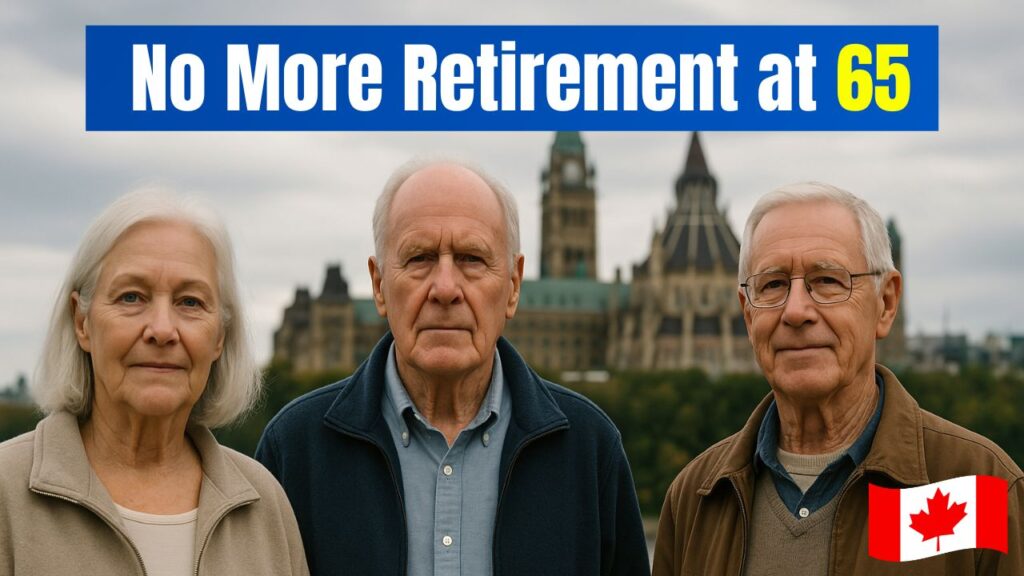Canada Ends Retirement at 65 November 2025 – The Canadian government has officially confirmed a major change in its retirement policy, announcing that the standard retirement age of 65 will end on 20 November 2025. This significant update is set to reshape how older Canadians plan their long-term financial security, especially those preparing to access their pension benefits. The reform is part of a broader national effort to strengthen income support, extend working opportunities, and adjust retirement pathways according to modern economic realities. As Canada moves toward this new pension age system, individuals are encouraged to understand how the upcoming change will affect eligibility, benefits, and long-term retirement planning.

New Retirement Age Policy for Canadian Citizens
The decision to end the traditional retirement age of 65 marks a major shift for Canadian citizens who rely on structured pension timelines. This updated policy introduces a more flexible retirement age framework that better reflects longer life expectancy and evolving employment trends across the country. Many individuals may see new options to delay their pension for higher monthly benefits or access support earlier under special criteria. While the federal government has emphasized better protection for long-term financial stability, citizens must stay informed about any adjustments to Old Age Security (OAS), the Canada Pension Plan (CPP), and employer-based retirement programs. Understanding these modifications will help Canadians make informed decisions as the 20 November 2025 deadline approaches.
 Ontario Launches Full C$80,000 HST Rebate for First-Time Homebuyers on Homes Up to $1 Million
Ontario Launches Full C$80,000 HST Rebate for First-Time Homebuyers on Homes Up to $1 Million
Pension Age Adjustment Impacting Older Canadians
The pension age adjustment will have a meaningful impact on older Canadians, especially individuals nearing the former retirement benchmark of 65. With the end of the fixed age requirement, retirees may face new rules regarding benefit calculation, deferral options, and income thresholds. For many households, this change represents a chance to secure higher pension payouts if retirement is delayed beyond the revised minimum age. Others may benefit from new early-access pathways designed for workers in physically demanding careers or those with limited financial support. As Canada shifts to this updated pension model, older adults must evaluate how the change aligns with their work-life plans, health status, and long-term savings goals.
| Retirement Component | Current Rule | New Rule (20 Nov 2025) |
|---|---|---|
| Standard Retirement Age | 65 years | Flexible age based on revised criteria |
| CPP Pension Access | 60–70 years | Potential wider range with updated conditions |
| OAS Eligibility | 65+ years | Likely revised with phased adjustments |
| Early Retirement Options | Available with reduced benefits | Modified rules for early access |
| Deferred Pension | Higher payouts for delay | Enhanced incentives under new system |
Canadian Retirement Reform and Long-Term Benefits
The new retirement reform is expected to offer long-term benefits for Canadians seeking financial security and stable income during their senior years. By eliminating the rigid 65-year structure, the system aims to provide improved flexibility and better align pension access with individual circumstances. This shift also prepares Canada for demographic changes, including the growing number of seniors and evolving workforce dynamics. With enhanced options for early or delayed retirement, the new system may encourage people to remain employed longer or retire based on personal readiness rather than a fixed national rule. For many, this reform could lead to more tailored retirement planning and stronger financial outcomes.
Retirement System Transition for People Across Canada
As the nation transitions to a revised retirement age structure, people across Canada will need clear guidance on how to adapt their retirement strategies. The government has indicated that updated resources, advisory tools, and digital retirement calculators will be introduced to support individuals navigating the change. Citizens may also see more employer-based planning assistance, particularly for those nearing the previous retirement age. With these tools, households can better estimate pension amounts, compare retirement scenarios, and understand how factors such as income, savings, and health influence ideal retirement timing. Staying informed will be essential during this nationwide policy shift.
Frequently Asked Questions (FAQs)
1. When does the new retirement age rule begin?
The new retirement age framework officially starts on 20 November 2025.
2. Will Canadians still be able to retire at 65?
Retiring at 65 may still be possible but will depend on new eligibility rules and benefit structures.
3. Does this change affect both CPP and OAS benefits?
Yes, both CPP and OAS may see updated conditions under the new retirement policy.
4. Will delaying retirement offer higher pension payments?
Delaying retirement is expected to continue offering higher monthly pension benefits.



